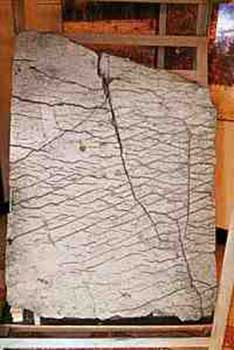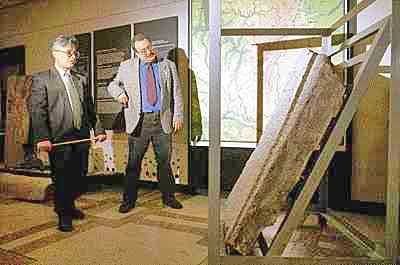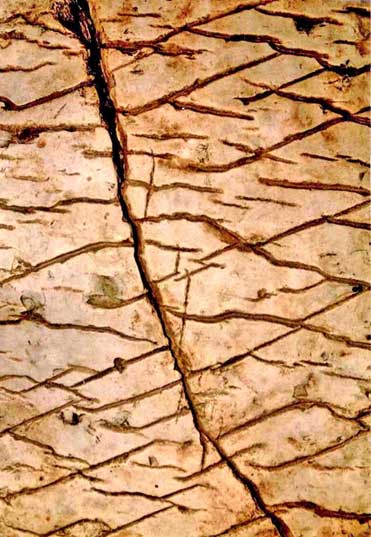
The Controversial Dashka Stone: 120 Million-Year-Old Map?
The Dashka Stone is a controversial artifact that it is believed by some to be the guidelines used by the architect of the world. Known as the Map of the Creator, this stone tablet has baffled researchers since its discovery in 1999. As impossible as it may seem, Russian experts believe the stone map, could be 120 million years old.
The Dashka slab depicts not only the environs of the Ural Mountains, but also a series of civil engineering projects including 7457 miles (12,000 km) of channels, several dams, and hieroglyphic notations of unknown origin. The accuracy and perspective of the map suggest that it was created from an aerial point of observation. The hieroglyphs have not, as of the time of writing, been deciphered but are thought to be related to an ancient form of Chinese.

Map of the Creator (urbanexplorerxfiles)
Archeologists from the Bashkir State University discovered the Dashka stone in the Ural Mountains of eastern Russia on July 21, 1999. The discoverers were immediately struck by the size of the tablet. It measures 58 inches (148 cm) high, 42 inches (106 cm) wide, 6 inches (16 cm) thick, and weighs one ton. Upon further examination, the researchers were even more stunned: the tablet appears to show a highly accurate topographical map of Bashkiria, a specific area of the Ural Mountains, at a scale of approximately 1:1.1km. Alexandr Chuvyrov, a professor at Bashkir State University who led the team, named the stone Dashka in honor of his granddaughter who was born on that day.
- The Spectacular Ancient Megaliths of the Ural Mountains
- 1,000-year-old Chinese tomb contains spectacular murals, touching poems, and ceiling of star constellations

Photo of Alexander Chuvyro next to the Dashka Stone. (bibliotecapleyades.net)
“At first sight, I understood that was not a simple stone piece,” said Chuvyrov. “But a real map, and not a simple map, but a three-dimensional. You can see it yourself.”
The Map of the Creator is comprised of three levels, strongly suggesting that it did not originate in nature but was artificially made. The first layer is roughly 7 inches (18cm) of a cement or ceramic compound based on dolomite. The second layer is roughly 1 inch (2.5cm) of diopside glass enriched with silicon. The third layer is only a few millimeters thick and is made of a calcium-porcelain mixture, perhaps to give the tablet added protection or perhaps to create a diffused light to better illuminate the stone.

Dashka stone. Phot from (bashturist.ru)
“How did we manage to identify the place?” said Chuvyrov. “At first, we could not imagine the map was so ancient. Happily, relief of today’s Bashkiria has not changed so much within millions of years. We could identify Ufa Height, while Ufa Canyon is the main point of our proofs, because we carried out geological studies and found its track where it must be according to the ancient map. Displacement of the canyon happened because of tectonic stabs which moved from East. The group of Russian and Chinese specialists in the field of cartography, physics, mathematics, geology, chemistry, and Old Chinese language managed to precisely find out that the slab contains the map of Ural region, with rivers Belya, Ufimka, Sutolka. You can see Ufa Canyon – the break of the earth’s crust, stretched out from the city of Ufa to the city of Sterlitimak. At the moment, Urshak River runs over the former canyon.”
- Ancient nanostructures found in Ural mountains are out of place and time
- Mysterious, Giant Face Found on Cliff in Canada—Man-Made or Natural?
The Dashka stone undoubtedly points to a Ural civilization more advanced than previously suspected, however, the claims that it was made 120 million years ago by a geographic Creator are mostly likely false. The Bashkir researchers derived this date from a pair of ancient seashells found locked in the stone slab. The first shell, Navicopsina munitus of the Gyrodeidae family, could be as old as 500 million years. The second shell, Ecculiophalus princeps of the Ecculiomphalinae subfamily, could be as old as 120 million years. Why these shells, still intact, were incorporated into the tablet or if they were purposefully included at all cannot be known for certain. Scientists suspect that, aside from the ancient shells, the tablet was made approximately 3000 years ago, however, it is exceedingly difficult to radiocarbon date the engravings themselves. This is still an incredible date, given the detail and advanced craftsmanship of the map.

Close-up of the Slab (bibliotecapleyades.net)
Some commentators are even more skeptical, claiming that regardless of the age of the stone, it is just an accident that the fissures resemble Bashkiria. To these doubters, the cracks are no map, just an interesting coincidence.
Top image: Image of the slab (bashturist.ru) and Uralskiy region with similar image. (CC BY 3.0)
Sources:
Forbidden History. "Russian "Map of the Creator"" Forbidden History. N.p., 2016. Web. 28 Aug. 2016. https://www.forbiddenhistory.info/?q=node%2F72
Ivan. "Researchers Find a 120-Million-Year-Old Map." The Unexplained. Ancient Code, 2015. Web. http://www.ancient-code.com/researchers-find-a-120-million-year-old-map/
Pravada.Ru. "The Map of "the Creator"" Pravda Report. Pravda.Ru, 30 Apr. 2002. Web. 28 Aug. 2016. http://www.pravdareport.com/news/russia/30-04-2002/42113-0/
















Comments
If the stone had been120 million years old it would have worn down and nothing would be left of it. Whole mountain ranges have worn down and formed sedimentary rock. Think of the Grand Canyon.
Vivian
There are NO close up /macro photographs of the surface, and none of any alleged ancient hieroglyphics, so its just a piece of rock until God says otherwise!
Dolomite and Diopside glass slabs like this can be found everywhere Limestone (Dolomite) deposits have been covered through time and then uncovered later.
The Limestone is buried. Then weight, heat and salts chemically create the secondary layers along fissures. Then further weight and heating/cooling fractures the stone. Water soaks through Decomposing Vegetation to create Carbonic Acid. The Carbonic Acid then eats at the underlying softer limestone where the fractures happen to be in the layer of harder Diopside Glass creating these type of common examples.
Slabs like this can be found all over the world in areas where Limestone Caverns have been formed. It just happens to be a coincidence that the markings resemble the map of the area.
Why is it difficult to date the engravings? Isn’t there patina in them? If no patina exists, then I would deem it a fake because no engraving could exist in a stone that is exposed to the elements or buried without accumulating debris. As for dating the seashell, that is useless in dating the engraving as whenever engraved the stone could have picked it up anywhere.
This object should be considered in context with the many other anomalous objects found in the Urals.
As for the age given of 120 million years, until Uniformitarians get around to factoring catastrophic events into their stratigraphy dating models, the numbers they use should be considered more as common placemarks than as actual spans of time.
Pages